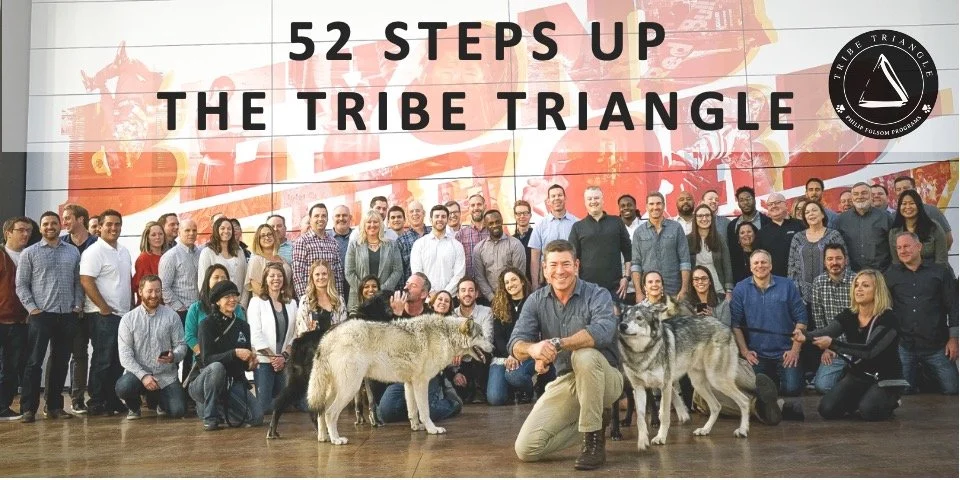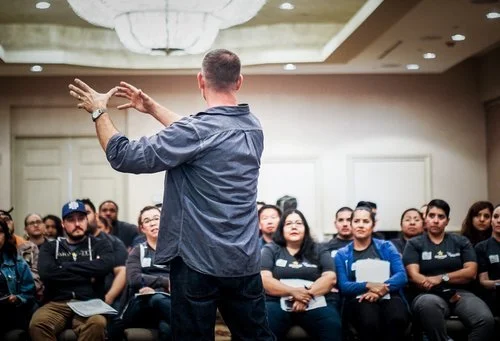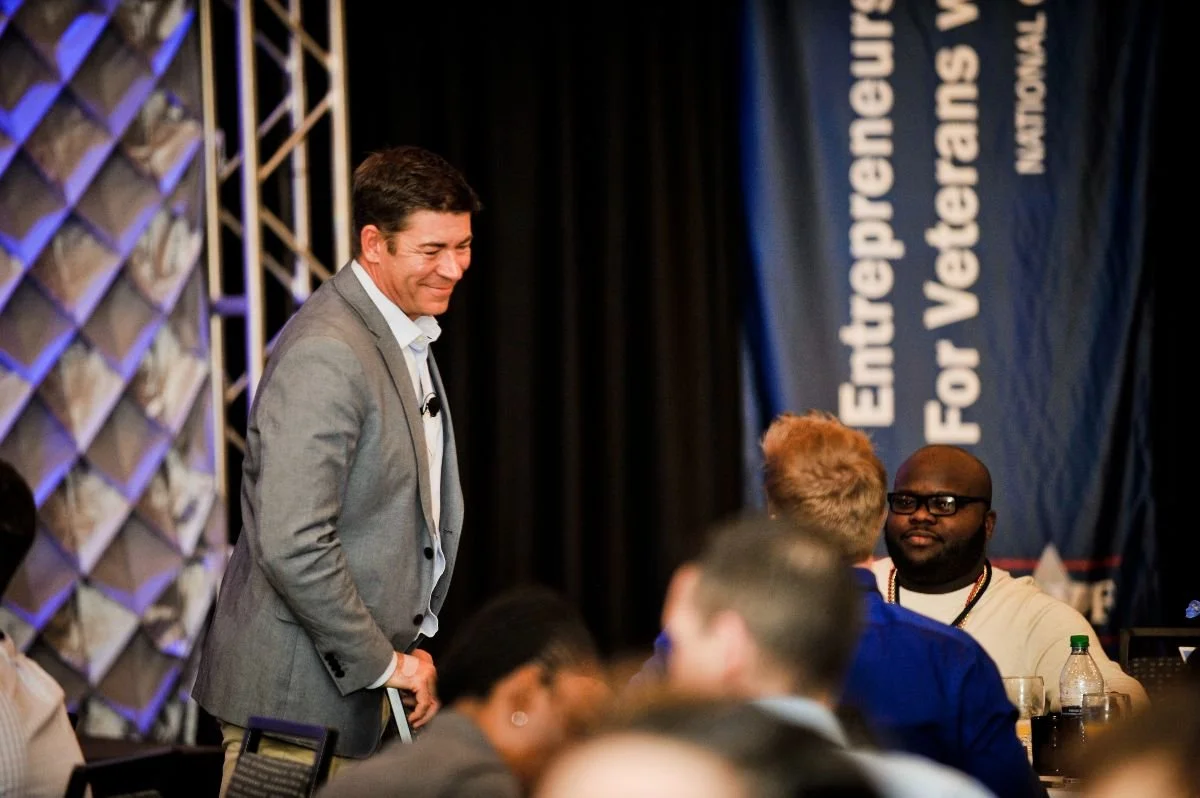Step 42 Up the Tribe Triangle: Leaders Create Leaders
“Leaders don’t create followers, they create more leaders.”
-Tom Peters
We are experiencing an evolution of leadership.
The top down, authoritarian leadership model of central control is dead. If you are still trying to implement this with your family and work team, your sustainable success will be dead too. That outdated model was killed by the ever-accelerating rate of change which demands the active participation in the innovative worldview of autonomous leaders.
This new reality was initially discovered and implemented in the military that noticed the unpredictable and lightning-fast tactics of insurgents dismantling the old central control culture of the military which was too slow to respond effectively to rapidly changing battlefields. This awareness led to driving autonomy down to the lowest level possible. This meant empowering soldiers to make immediate decisions in the actual battlefield where the action is actually happening instead of waiting for directions from a distant and remote leadership structure.
“Great leaders create movements empowering the tribe to communicate. They establish the foundation for people to make connections, as opposed to commanding people to follow them.”
-Seth Godin
Big corporations are faced with the same challenges in today’s world of fast changing technology and information. This is why big companies lose the small battles that become big movements. The companies that adopt the most empowering leadership structure with the most autonomous leaders at every level win.
“Evolution is not survival of the fittest. It is survival of the most adaptable.”
-Philip Folsom
Leadership skills used to be a valuable but optional trait of individuals, families and work teams. Leadership skills are now mandatory for both surviving and thriving. Leaders are the ones that see a vison for the future that does not exist. They are also the people with the ability to take risks and decisive actions to move projects and procedures toward that future. That future will contain challenges and opportunities appearing on the horizon at an ever-increasing rate. Creating leaders is a survival strategy.
Creating leaders is valuable and has a price. Here’s how to pay it.
Responsibility is the ability to respond. Leaders have this, however, like everything at this stage of the Tribe Triangle there is a cost required.
Leaders are the people willing to take on the heavy burden of authority and accountability to make decisions as well as the burden of mistakes. Mistakes will be made and unless you have established a culture of resiliency and grit, leaders will not appear. If you are not seeing your people regularly stepping up into leadership, review the chapters on resiliency, risk-taking and grit and recommit to the work there. You will see transformation.
The ability to create more leaders on your team will involve risk and conflict. Leaders make decisions and these decisions will affect other people, projects and procedures. Some of these decisions will fail. Until you have established your Healthy Conflict level of the Tribe Triangle you will struggle with people stepping up into leadership. Continually encouraging risk and accepting failure will make it safe for your people to step into their leadership potential.
“The manager accepts the status quo; the leader challenges it.”
-Warren Bennis
Transparently celebrating your successes and admitting your own mistakes will normalize the opportunities and challenges that come with leadership. This will also reinforce the fact that leadership development is ongoing and no one is perfect.
Your legacy as a leader will not be what you accomplish.
It will be the leaders you create.
Empowering your people to claim their intrinsically motivated sovereignty is the magic bullet for ongoing engagement and overall performance. Everyone has talent and everyone has ambition. Can you unlock it?
“Leaders create and inspire new leaders by instilling faith in their leadership abilities and helping them develop and hone leadership skills they don’t know they possess.”
John C. Maxwell
More and more, today’s contemporary workforce wants to be part of the decision-making that creates results. People want to be able to express themselves and be active participants in moving toward meaningful and significant things. Active involvement in meaningful, purposeful projects is in the top of young professional’s demands for commitment to a company.
Nurture the inherent leadership in every member of your team. We can draw this out by our direct engagement with these people. Remember, appreciation is a form of paycheck that you have an unlimited amount of. Use it. Recognizing the leadership traits and behaviors of your people will accelerate their leadership development and has a tremendous culture and performance return on investment.
“Leadership is not defined by the exercise of power but the capacity to increase the sense of power among those led. The most essential work of the leader is to create more leaders.”
-Mary Parker Follett
Creating more leaders is a force multiplier of success in your family and business. More leaders exponentially increase organizational change and innovation. More leaders equal more growth because leaders are ambitious risk takers. The more leaders your team has the more avenues, ideas and perspectives you have. Leaders lead the way to improved problem solving. The creativity and communication required for leadership provides more minds and perspectives to bring to bear on challenges.
“Innovation distinguishes between a leader and follower.”
-Steve Jobs
Leadership involves intrinsic motivation and this increases the overall motivation in your team. This has an immediate positive impact on engagement, retention and every aspect of performance. Intrinsically motivated leaders also exhibit higher morale and resiliency.
We create more leaders by exhibiting leadership ourselves. When we model altruistic, vision and value-aligned leadership we inspire the leadership of others.
Have empathy for your new leaders. Consciously reflect on your first, challenging experiences leading a project or team. Imagine how much better and faster your journey of leadership would have been with the right mentor and coach. Be that person you never had for the people you do have. Active mentoring and coaching your people not only engages and directs their leadership development but also shows you care and creates a positive, reciprocal feedback loop.
“Before you are a leader, success is all about growing yourself. When you become a leader, success is all about growing others.”
-Jack Welch
Leadership is a verb more than it is a noun. Leadership is doing and for that to happen, people need opportunities to lead. Create that for them. Often this initial investment in developing leadership will be a loss because, as you know, leadership is hard and mistakes will be made. However, people get better at the things they do consistently and your investment in your leaders will eventually break even and then be the best investment you ever made.
The leaders you make will make more leaders and the compound interest of this dynamic can change entire business and communities for generations to come. Leaders accelerate performance and create more leaders. This exponential increase in autonomy empowers performance in every aspect of your tribe.
“A leader is best when people barely know he exists,
when his work is done, his aim fulfilled, they will say: we did it ourselves.”
-Lao Tzu
Click here To watch the video of Step 42: Leaders Create Leaders
Leaders Must Write and Speak
Answer these questions in your journal by really writing them down. Discuss them with at least one of your most important people and really listen to their response.
Where do you see your people unwilling to take leadership of projects and waiting for your decisions?
Why do you think they are doing this? If you don’t know the answer to this, ask them.
Ubuntu,
Philip Folsom









